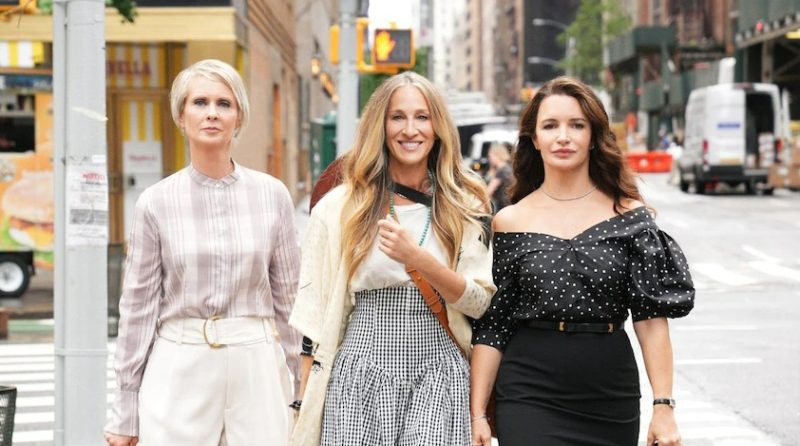Luxury is wasted on the young, but not the young at heart
While the ‘Sex in the City’ reboot ‘And Just Like That’ clearly polarised some fans, Giorgia Butler, head of strategy and innovation at Nunn Media writes about luxury and the importance of luxury brand marketing to the ‘older generation’ back into focus.
Love it or loathe it, I have to admit to a quiet enjoyment of HBO Max’s reboot of Sex and the City, And Just Like That.
The ultra woke storylines, ostentatious fashion and the sheer amount of botox alone are enough to keep me entertained after a busy day of zoom calls and caffeine. But more than that, the show has highlighted a concept dear to my heart – the impact older representation can have when we remove ageist stereotypes in the media. And there’s one big stereotype this show has made me question; is this what luxury looks like now?

There’s no doubt the show is packing a punch when it comes to influence. Within the first two episodes going to air, interest in high-end designer brands featured on the show skyrocketed, with search for a floral print jacket by Dries van Noten, (which retails for around $2,000) increasing by 1,150%, and the linen jumpsuit under it also sparking a 500% spike in search for ‘linen jumpsuits’ in general.
While it’s almost certain this search behaviour was not exclusive to ‘women of a certain age’, what is abundantly clear is that Sarah Jessica Parker at age 56 wields just as much (if not more) influence on the fashion-conscious consumer than she did at 26 or even 36.
This begs the question: luxury – who is it really for?
Australians aged 60+ hold 46% of Australia’s disposable income and 50% of our private wealth. They have heightened expectations of what retirement means, from the brands they buy, to the cars they drive and what travel should look like.
This cashed up group is hungry for the finer things, having worked hard, paid off the mortgage in a majority of cases, and feeling they have earned the right to reap the rewards. Since the arrival of COVID, they have accelerated their use of social media, digital publications, streaming, online shopping and banking, giving them new ways to browse and buy whatever they want; hello Net a Porter!
They are digitally savvy, ready to engage, browse and shop online, especially across the luxury marketing sector. And we’re not just talking about shoes and handbags here. Case in point; Rolls-Royce sold more cars in 2021 than it had in its entire 115 year history, while US yacht sales hit a 13-year high in 2020.
Social status driving luxury brands
Humans are social animals and as such will pay a premium for items and experiences that elevate their status compared to others – even subconsciously.
Over thousands of years, we have evolved to put a premium on certain factors that elevate or diminish our social status, because social status has historically been a life or death matter. Now, what we drive, wear, eat and drink is a marker of human success and strength in the face of perhaps the most uncertain times in living memory.
“Humans live in a social world in which relative rank matters for nearly everything – your access to resources, your ability to attract mates, and even how long you live,” said UT Austin evolutionary psychologist David Buss. “From an evolutionary perspective, reproductively relevant resources flow to those high in status and trickle slowly, if at all, to those lower on the social totem pole.”
So if social status for the young tracks back to reproductive relevancy, how does it shift as we grow older and less fertile?
French writer Victor Hugo said: “forty is the old age of youth” and “fifty the youth of old age”. So perhaps social status is a question of perspective… as someone in their mid-forties, I definitely feel like the biggest kid at the kids’ table, and the smallest and least experienced at the adults’ table.
This makes social status a bit of a moving target relative to age.
For those working with luxury brands, following the money and the desire for the finer things will lead to an audience north of 50. By working out what makes older Aussies feel socially desirable, brands have the opportunity to really engage with this often misrepresented demographic.
It is a worthy challenge for creative problem solvers. If marketers can crack the code of social status among the cashed up and well heeled 55+ audience, then it seems they can expect their business to boom, thanks to the boomers.

Giorgia Butler
Giorgia Butler, head of strategy and innovation at Nunn Media


“Case in point; Rolls-Royce sold more cars in 2021 than it had in its entire 115 year history.”
I doubt that statement’s veracity in the way it is worded. Yes, with global annual sales of 5,586 in 2021 they did eclipse the 5,100 global annual sales of 2019.
But to say that they sold more than in its entire 115 year history is gilding the lily … on steroids. In the previous decade (2011-2020) sales amounted to 39,116.
I hope you meant to write “Rolls-Royce sold more cars in 2021 than it had in any other year in their entire 115 year history”.